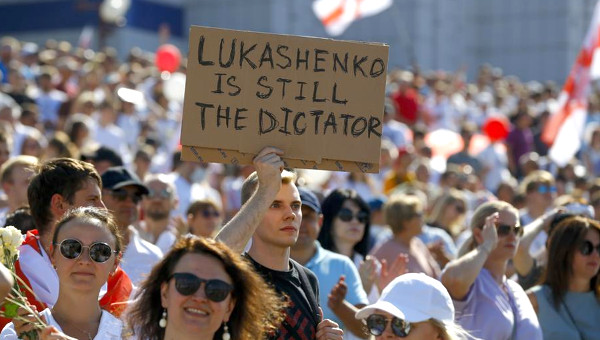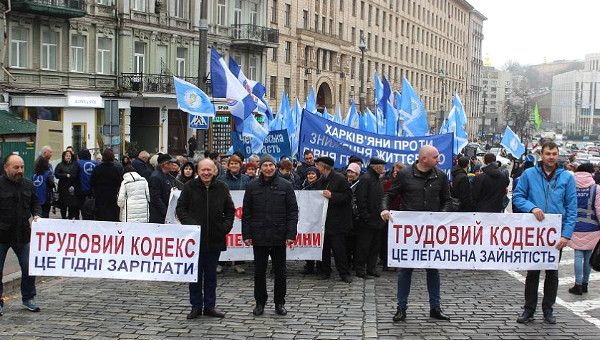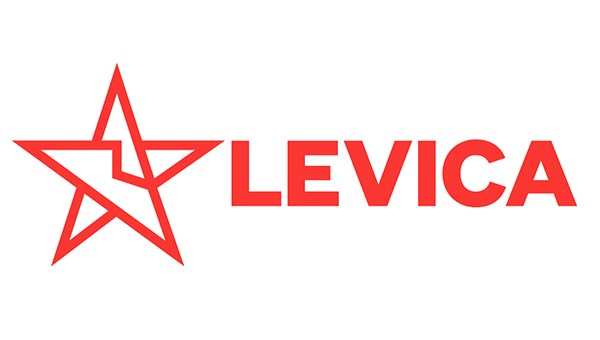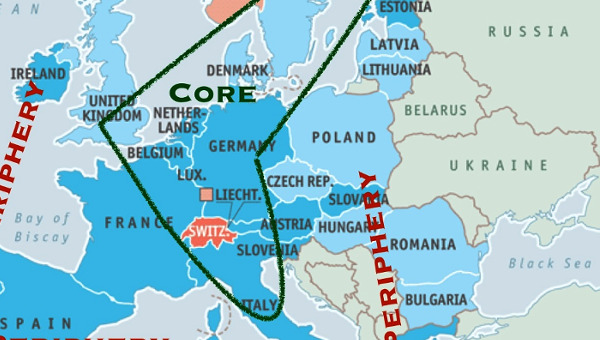The Left in Belarus Is Fighting to Put Social Demands at the Heart of the Protests
The police brutality in Minsk is often said to be without parallel in Europe: something that France’s gilet jaunes protestors would surely deny. Yet something definitely is changing in Belarus, after unprecedented popular support for opposition candidates challenged the twenty-six-year rule of president Alexander Lukashenko. When authorities claimed that he had taken 80 per cent of the vote in the August 9 election – and crowds took to the streets to protest – the state unleashed police terror against them.
The street demonstrations were initially dominated by urban youth. Yet, as I have shown in a recent article, the protest has in recent days changed form, expanding into a wider working-class movement involving widespread workplace mobilizations. Actions spanning most of the country’s biggest industrial sites have seen thousands of workers gathering, discussing their demands, and threatening a general shutdown.
So, everything in Belarus is said to be “unprecedented.” Yet one can, indeed, find precedents, in Poland’s Solidarnosc or the miners’ strikes in the late Soviet Union – examples of worker militancy allied to wider protest movements that unwittingly paved the way for neoliberal transformations. The tragic story of labour in the post-Soviet space thus calls for a careful and grounded approach to the recent events in Belarus.
In order to shed some light on the contradictions of Belarusian society and the condition of its working class, Volodymyr Artiukh, on behalf of Jacobin, interviewed two representatives of the Belarusian left, who asked not to reveal their identities. “Ksenia Kunitskaya” is a member of Poligraf online magazine, and “Vitaly Shkurin” is a Belarus-based author of September, a leftist media platform covering the post-Soviet space. Both of them have connections in activist circles and are well placed to assess the situation from a working-class perspective.
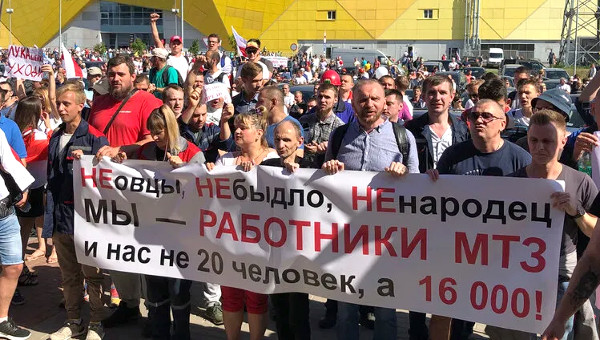
Volodymyr Artiukh (VA): It seems that neither analysts nor Belarusian authorities expected unrest on this scale around the elections that took place on August 9. What sparked the pre-electoral mobilization and the subsequent protests? In what wider political conjuncture should we see them?
Ksenia Kunitskaya (KK): The first reason is the fatigue that has long built up among much of the population on account of Lukashenko’s quarter-century rule. His approach is apparent in his abrupt style of communication with both opponents and his own subordinates, often resembling casual rudeness. This is aggravated by the indifference shown by local officials, following not the mood of the people but the mood of the leader. These qualities clearly manifested themselves during the government mishandling of the COVID-19 epidemic, which massively irritated the population.
Additionally, the government has been consistently dismantling the welfare state model and its social obligations to its citizens. This was apparent with the 2004 introduction of individual contracts with workers instead of collective agreements; the 2017 “tax on unemployment”; and the exclusion of military service, maternity leave, and university or college studies from the years that count toward your pension. The tight monetary policy of the past five years also led to a wage freeze, while prices continued to rise.
Vitaly Shkurin (VS): The last ten years saw a depoliticization of Belarusians. After the failed post-election protests of 2010 and the subsequent “clapping revolution” [when people clapped in the street to show their dissent, fearing that they would be arrested if they mounted protests], many members of parties and movements suffered state repression.
In 2017, after the government introduced the so-called tax on unemployment, Belarus saw protests not only in Minsk, but also in small provincial towns, for the first time in six years. This tax was then postponed. But it seemed that after the defeat of oppositional parties and movements, the new opposition to Lukashenko appeared only in the vague form of “Belarusians.”
Since a substantial share of Belarusian economy is still state-owned, the “common people” – Lukashenko’s own usual voters – consist of workers of state-owned factories, schoolteachers, or doctors. In recent years, the public sector has been starved of money, which led to falling wages, contraction of the labour force, forced unpaid vacations, and a rising retirement age. Obviously, this did politicize the “common people,” but unfortunately no strong positive agenda emerged.
KK: Besides, the authorities paid little attention to their positive image in the eyes of the population. Our state propaganda is very weak and often looks ridiculous: “We have never lived as well as we do now,” they claim. Their opponents, however, have created an effective system of professional, modern, electronic media. Through this, they highlight the state’s shortcomings and conduct propaganda in favor of neoliberal reforms and a nationalist memory politics. This allowed the liberal-nationalist opposition to mobilize supporters before the elections, to catch the authorities on numerous cases of vote rigging, and to bring people to the streets.
Additionally, the harsh police actions – the use of stun grenades, water cannons and tear gas, tortures of the detainees – aroused indignation not only among opposition supporters but also shocked those who were not previously interested in politics.
VA: What kind of Belarusians have tended to support Lukashenko – and is this support now coming apart? Is this to do with the weakening of the tradeoff of “no political rights, but still welfare rights”?
KK: After Lukashenko’s first electoral victory in 1994, his support was very wide, comprising proponents of an alliance with Russia and the revival of the USSR, opponents of tough market reforms, and Russian speakers dissatisfied with the policy of “Belarusianization.” Village residents perceived him as “their guy.” In the 2000s, he attracted supporters with a policy of constant wage growth, promising to bring the average salary to $500 and even $1,000 a month.
A series of economic crises prevented this dream from being realized. The union with Russia also suffers due to the contradictions among Russian and Belarusian elites. And the campaigns to raise wages were replaced by a tight monetary policy, in the spirit of IMF recommendations.
Independent sociology in modern Belarus is practically banned, and state-associated sociologists do not publish data, so it is difficult to judge the president’s real ratings. Obviously, it is less than in the 1990s and 2000s, and the harsh police actions clearly did not add to his popularity. At the same time, the opinion popular among the opposition that Lukashenko’s rating is only 3 per cent is most likely a myth.
VS: I think that Lukashenko’s economic model based on the re-export of Russian oil has exhausted itself, since Russia increased its oil price for Belarus and global prices plummeted. Obviously, Lukashenko cannot sustain the current level of welfare for the population, so for him, neoliberalism seems to be the only exit route.
However, we must remember that a high share of employment in the public sector means that workplaces are also sites of political control. As the unofficial unemployment rate in Belarus is quite high (about 10 per cent) and unemployment benefits are about $10 per month, being unemployed is not very comfortable. Public-sector employees must regularly participate in other activities to save their workplaces: working Saturdays, voting in early elections (where falsifications mostly occur), and even participating in elections as members of electoral committees and falsifying results. Employment in the public sector is based on fixed-term contracts that prevent an employee from easily leaving – but allow an employer to get rid of the worker at will. Obviously, at some point, many public-sector employees realized that there is no way out, except for voting against Lukashenko.
At the same time, we can identify new strata that support Lukashenko: his servants in the sphere of ideology and power. By the former, I mean a new generation of pro-government “public experts” employed in various state-owned institutions (from universities to dubious “public organizations”). They are regular guests on state-owned, independent, and foreign media, where they promote the Belarusian state. As opposed to the old establishment of boring Soviet-style clerks, these people are bright in their speeches and their appearance. The old Soviet-style official establishment also strongly supports Lukashenko, as outside of his system they are useless.
The police and secret services are the second stratum of Lukashenko supporters. They have special welfare benefits that include subsidies for the purchase of housing, early retirement, health care in special clinics, vacation in sanatoriums, etc. The number of police in Belarus is not publicly known, but the interior minister said in 2016 that there are 405 police officers per 100,000 citizens, and according to a 2013 UN estimate, this number is 1,442 per 100,000. This job is also a significant factor for social mobility: people from small towns without employment can move to bigger cities to work as police. In exchange, they must blindly obey orders: we can see the outcome on the first days of the protests, when stun grenades and tear gas were used against relatively small and disarmed groups of protesters. Police and secret services are outside of public control, and, significantly, the new, shiny “ideology men” have ties with them.
VA: How would you describe the social constitution of the protesters, their social and class profile, ideologies, and grievances?
KK: First, there is the traditional opposition from the 1990s: nationalists, liberals, and the intelligentsia sympathetic to them. Second, there are urban youth, businessmen, and the likes of IT specialists, who call themselves progressive, Western, and anti-Soviet. During the election campaign, the opposition headquarters managed to mobilize a slightly wider population, at least from large cities. The politicization in society during the pre-election days was extremely high. A lot of disaffected citizens were actively involved as election observers.
Now, wider sections of the society are joining, shocked by the unprecedented police violence and outraged by electoral fraud. Some of them had been dissatisfied with their economic situation but had passively supported Lukashenko as the “lesser evil” compared to the right-wing opposition. The national liberals involved in the electoral process did not speak openly about their program, only about fair elections and later about reducing police violence as an end in itself.
VS: Despite many orthodox communists’ belief that this is a “hipster-programmer revolution,” many young protesters are factory workers, taxi drivers, and students. I don’t think we can attribute any specific ideology to this spontaneous movement. Protesters carry Belarusian official [green-and-red] flags as well as the old flags [white-red-white flags that served as national symbols in 1991–1994]. Since the latter dominate, some argue that the protests are nationalist. But as I said, the leaders of the traditional nationalist opposition are in jail, and there were no conflicts about symbols among protesters. When protesters started using violence against the police, we can suspect that the organized football fans were involved, but they are still small groups.
VA: How would you compare these protests to other mobilizations in Belarus and in the region?
VS: All protests before 2010 had a strong nationalist politics, but already the 2011 “clapping revolution” had no such agenda. After Ukraine’s Maidan in 2014, nationalism was back in vogue among protesters – it became commodified as a brand of new, successful, more “European” Belarusians. The current protests are even further removed from nationalism and rather more reminiscent of the protests of 2017, when large crowds all around Belarus protested against the tax on unemployment.
This year’s protests have two peculiarities: they lack any political and social agenda apart from contesting election results, and they are scattered around Belarus. Before 2017, almost all big demonstrations happened in Minsk and followed the same scenario: big procession through the city center, gathering on a big square, and the subsequent hard beating by police. Except for 2006, when there was a tent camp on the main square, they lasted for a day. But these protests have already lasted for four days in different cities and towns, not only in Minsk. Even in the capital, protesters do not occupy one place, mostly because the city center is under police control from early evenings. Throughout the evening and night, protests can happen in different districts; protesters run from the police and return after police’s retreat.
KK: Most significantly, the scale of violence has become such that it is no longer perceived as an abstract picture in the news. A huge number of people have seen and experienced this themselves or have victims among friends and relatives. The opposition does not formally propose anything that could lead to a conflict of interests of different classes and social groups, only new elections – this has become an additional mobilization factor.
VS: Most violence comes from the police: never before in Belarus were flash grenades, tear gas, and rubber bullets used on such a scale. I think the state wanted to intimidate protesters, but this had the opposite effect of prolonging the unrest. Besides, the scale of violence is clear from the amount of people detained – never before did we have three thousand people in jail over one night.
Finally, on the fourth day after the elections, we saw a new dimension of protest activity: statements from labour collectives across the country about possible strikes. Unfortunately, these statements mostly do not include any social demands, only the demands to stop the police violence, release all detainees, and hold fresh elections. Anyway, there has been no (legal) strike activity in Belarus since 1991.
Also, the internet as the efficient communication medium was used for the first time, although during the first three days of protests, foreign internet traffic was disrupted, and most people used VPNs and proxy servers. Thus, by analogy with “Twitter revolutions” during the Arab Spring of 2011, the protests in Belarus can be called a “Telegram revolution.” Telegram messenger was founded by Pavel Durov after his emigration from Russia, and it became popular among post-Soviet users to buy drugs (basically it resembled access to a dark net, only without any hard technical skills being needed on the user’s part). In 2018, a young emigrant from Belarus in Poland started the Telegram channel “Nexta” (“нехта,” meaning “someone” in Belarusian), and it gained popularity among Belarusians because of “insider” posts about Belarusian authorities.
Obviously, one guy can’t organize a network of insiders, and there are suspicions that various journalists and media specialists who emigrated during the years of Lukashenko’s rule work for it. Nexta and a network of affiliated Telegram channels shared photos and videos from different spots during the protests. Before the first protest night, they posted “instructions on how to protest carefully,” but without radical things like recipes for Molotov cocktails. Besides, Nexta provided scenarios of protests that people mostly followed. If, on the first night, this scenario was one place in Minsk and big squares in small towns, on the next two nights, the scenario implied movement of small groups in Minsk’s sleeper districts and big streets in small towns. Sometimes Nexta was really provocative: “Just one last push, let’s show the police our solidarity,” “[Town X] calls for help, police are beating our women.” After the internet started working, Telegram channels lost some of their influence. The protests started occurring mostly in daylight and had exceptionally peaceful character, mostly in the form of “chains of solidarity”: lines of people, mostly women, holding flowers along the main streets.
I don’t see similarities between these protests in Belarus and previous protests in Eastern Europe. Some try to find similarities with Euromaidan in Kiev in 2014, but this is a purely ideological tool to justify Lukashenko and show that no alternative is possible. In contrast to Euromaidan, Belarusian protests have no big far-right groups that lead and use violence. We have a couple of ultras gangs, but after Euromaidan, most of them were repressed by the police. In Belarus, there’s no language and ideological conflict, as in Ukraine. Finally, in contrast to Euromaidan, the Belarusian protests have no leader: traditional opposition figures are in jail, and the presidential candidate Sviatlana Tikhanovskaya is in Lithuania. I am absolutely sure it can’t lead to war like in Donbass: there’s no ideological conflict between West and East, as in Ukraine in 2014.
VA: How would you describe the current situation of the Belarusian left?
KK: The left-wing movement has been in crisis for a long time, because Lukashenko himself used quasi-socialist slogans to come to power. When right-wingers call him “Soviet” and “communist,” he doesn’t seem to mind. Soviet monuments, street names, and holidays have been preserved in full in Belarus. So, somehow it was “decided” that he was a “leftist.” Additionally, under a dictatorship, only those non-state political forces and media can survive that are fed from abroad. It is well known that large American and European funds donate money to non-communists.
As a result, we do not have large left-wing media outlets and parties capable of supporting at least part of the leadership. Under these conditions, we have two “communist” parties. The first is called Communist Party of Belarus, and it supports the regime (including its most odious antisocial measures); the other, A Just World, supports the liberal opposition in demands for regime change, focusing less on the class agenda. There are also grassroots initiatives: Marxist circles, small media, interest groups, small associations of anarchists.
VS: The party of the Left “A Just World” split from the Communist Party in 1996 after Lukashenko’s first referendum shifted the balance of power toward the president. Today, it stands against both Lukashenko and against Western-oriented opposition. The Belarusian Green Party, founded in 1994 and oriented against nuclear energy, developed a left and anti-authoritarian agenda. It is quite strong and, in contrast to A Just World, is less oriented on Marxist-Leninist classics. Also, we’ve got three social-democratic parties, some of whose members do have strong social orientations, but most are part of the Western-oriented oppositional establishment.
Belarus used to have a big and strong anarchist movement, maybe the strongest in post-Soviet space, connected to a punk-hardcore scene. Some of them infiltrated the Green Party; some ended up in jail. It is hard to say anything about anarchists’ activity now, because they are still the main target of repression. Some anarchist groups don’t call themselves “left-wing,” for they wrongly associate it with pro-Soviet “tankies”; some find their support from the Western-oriented nationalist opposition.
Finally, a Russian fashion of “Left YouTube” and Marxist kruzhki (small self-education organizations) reached Belarus in recent years. Unfortunately, much of their content is not so much about their own agenda but a fierce criticism of the Western-oriented opposition. They charm their viewers with Soviet nostalgia or Soviet resentment more than propose a positive agenda for building a wide democratic social movement. This Left YouTube and kruzhki are not bad in themselves, but they can’t be seen as the only strategy for the Left, such as they often propose.
VA: What is the attitude of these various groups to this political conjuncture and the protests?
KK: Part of the Left is ready to directly support the liberal protest, mostly at the level of grassroots activist involvement and statements. Another part believes that the people have the right to protest, that the police violence is unacceptable and outrageous, and that the elections were rigged, but cannot take the side of the liberal opposition. For its goals are to continue the privatization of enterprises, to curtail free medicine, and introduce even more labour flexibility than we have now.
Recently, a small grassroots initiative has emerged with a purpose of bringing economic and social demands to the workers’ protest agenda, since at the moment, all workers’ protests are centered around broad political demands: Lukashenko’s resignation, the release of political prisoners, lawsuits against the security forces, fair elections.
VS: All the left-wing parties refused to participate in presidential elections during the pandemic; and anyway, they didn’t have enough resources to mobilize common people and activists to turn the popular discontent with Lukashenko into a socialist agenda.
At the same time, after the state had already started using repression against alternative candidates and their supporters before the elections, many kruzhki and YouTube activists decided not to take notice. They continued to reject any opposition to Lukashenko; some went looking for similarities with Euromaidan, warning of a catastrophic end in decommunization and repression from far-right groups. But mostly they insist on a cunning strategy to develop Left YouTube and kruzhki while the state grapples with the pro-Western, democratic opposition.
For me, this position is a big failure, because it ignores the mood among Belarusians. They are really tired of Lukashenko’s system, and obviously the Left must work with this, not just blame them for being blind sheep that will lead the country into a total market economy. Under Lukashenko’s system, working-class or grassroots organizations will never be able to change the situation.
At the same time, when on the fourth day of protests, working-class masses took to the streets and the possibility of strikes became real, almost no left organization or party actually opposed this movement. Everyone tries to organize a strike movement and propose social and economic demands to shift these protests from a purely electoral to a social agenda.
VA: To what extent is the working class taking part in the unrest, and what is the role of organized labour?
VS: Workers’ collectives from more than twenty state-own factories and organizations expressed their desire to strike. After Lukashenko’s first dismissive words about strikers (“there were about twenty strikers in some factory,” he claimed), some workers from the Minsk Tractor Works marched through Minsk to Parliament to demonstrate their opposition. In my view, this was not specifically class-conscious – it overlapped with the “chains of solidarity against violence.” But on August 14, outside Parliament, we could see workers with banners reading, “We are workers, not sheep.”
KK: There is only one large national trade-union association, the Federation of Trade Unions of Belarus, which has become part of the Lukashenko government’s bureaucratic apparatus. All its activities boil down to organizing celebrations of national holidays and issuing vouchers for rest homes. This “trade union” has nothing to do with protecting workers’ rights.
The few independent unions formed in the wake of the early 1990s upsurge in the labour movement were crushed. Only a few enterprises have cells, for example, of the Belarusian Independent Trade Union. These independent trade unions are now more similar to NGOs, relying less on workers’ contributions than on foreign grants. Their activities are focused on legal assistance to individual employees who have applied for them.
The last major protest by metro workers in 1995 was brutally suppressed by Lukashenko. Since then, there has been no talk of strikes. Now, we are seeing the first large protest movement of workers since then. So far, these protests look rather like meetings with the management of the enterprises, the “yellow” trade unions, and the local authorities. Now there is news that on August 17, Belaruskali potash miners are planning a strike (the Independent Union’s cell has survived there – its chairman was beaten half to death during his arrest). Workers’ collectives from the large factories threatened strike action, and this, at least at the time of writing, forced the authorities to rein in police violence.
But so far, workers have put forward only general democratic demands, in line with a broad liberal protest. The protests clearly marked a new trend: traditional political parties, whether left or right, played practically no role in them. The ideological and practical inspiration rather came from the media in a broad sense, including social media. Who has a strong media owns the mind. But now a strong media is in the hands of those who promote the liberal and nationalist agenda. And if the workers are indoctrinated in this, then where would a class-conscious labour movement come from? •


